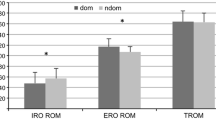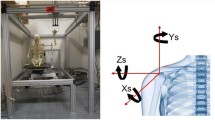Abstract
Introduction
To evaluate the kinetic amplitude and direction of the long head of the biceps tendon (LHB) within the pulley and the proximal bicipital groove, we performed a 3T-magnetic resonance—throwing motion analysis.
Materials and methods
This prospective study was performed on a 3T-MRI scanner. A T2-weighted-3D sequence in three specific positions of throwing motion of the dominant shoulder was performed under isometric 5 N loading conditions or without loading, respectively. Measurements were performed in high (140°) abduction/external rotation, medium (110°) abduction/external rotation and low (45°) adduction-flexion/internal rotation. Multiplanar rotational reconstructions along the LHB in the bicipital groove allowed for the localization of the LHB including the degree of motion in the three most proximal slices.
Results
12 healthy volunteers (age 22–34 years) were enrolled. Adduction led to an anterior deviation of the LHB within the bicipital groove. Loading conditions in medium (110°) elevation/external rotation furthermore led to a significant anterior deviation of the LHB.
Conclusion
Our findings support the thesis that pulley lesions result from movements of the LHB especially in extreme positions during throwing/overhead activities. Load application in the medium (110°) elevation/external rotation position might enable a better evaluation of patients with dedicated pulley lesions. These results need further evaluation in larger study cohorts and in patients with dedicated rotator cuff lesions, which will be the focus of ongoing studies.









Similar content being viewed by others
References
Baumann B, Genning K, Böhm D, Rolf O, Gohlke F (2008) Arthroscopic prevalence of pulley lesions in 1007 consecutive patients. J Shoulder Elbow Surg 17(1):14–20
Beaulieu CF, Hodge DK, Bergman AG et al (1999) Glenohumeral relationships during physiologic shoulder motion and stress testing: initial experience with open MR imaging and active imaging-plane registration. Radiology 212(3):699–705
Bennett WF (2001) Visualization of the anatomy of the rotator interval and bicipital sheath. Arthrosc: J Arthrosc Relat Surg 17(1):107–111
Bhatia DN, van Rooyen KS, de Beer JF (2008) Direct arthroscopy of the bicipital groove: a new approach to evaluation and treatment of bicipital groove and biceps tendon pathology. Arthrosc: J Arthrosc Relat Surg 24(3):368.e1–368.e6
Gerber C, Sebesta A (2000) Impingement of the deep surface of the subscapularis tendon and the reflection pulley on the anterosuperior glenoid rim: a preliminary report. J Shoulder Elbow Surg 9(6):483–490
Habermeyer P, Magosch P, Pritsch M, Scheibel MT, Lichtenberg S (2004) Anterosuperior impingement of the shoulder as a result of pulley lesions: a prospective arthroscopic study. J Shoulder Elbow Surg 13(1):5–12
Habermeyer P, Krieter C, Tang KL, Lichtenberg S, Magosch P (2008) A new arthroscopic classification of articular-sided supraspinatus footprint lesions: a prospective comparison with Snyder’s and Ellman’s classification. J Shoulder Elbow Surg 17(6):909–913
Itoi E, Kuechle DK, Newman SR, Morrey BF, An KN (1993) Stabilising function of the biceps in stable and unstable shoulders. J Bone Joint Surg Br 75(4):546–550
Jost B, Koch PP, Gerber C (2000) Anatomy and functional aspects of the rotator interval. J Shoulder Elbow Surg 9(4):336–341
Lee JC, Guy S, Connell D, Saifuddin A, Lambert S (2007) MRI of the rotator interval of the shoulder. Clin Radiol 62(5):416–423
Levy AS, Kelly BT, Lintner SA, Osbahr DC, Speer KP (2001) Function of the long head of the biceps at the shoulder: electromyographic analysis. J Shoulder Elbow Surg 10(3):250–255
Morag Y, Jacobson JA, Shields G et al (2005) MR arthrography of rotator interval, long head of the biceps brachii, and biceps pulley of the shoulder. Radiology 235(1):21–30
Rodosky MW, Harner CD, Fu FH (1994) the role of the long head of the biceps muscle and superior glenoid labrum in anterior sabiliy of the shoulder. Am J Sports Med 22:121–130
Sakural G, Ozaki J, Tomita Y, Kondo T, Tamai S (1998) Incomplete tears of the subscapularis tendon associated with tears of the supraspinatus tendon: cadaveric and clinical studies. J Shoulder Elbow Surg 7:510–515
Walch G, Nove-Josserand L, Levigne C (1994) Tears of the supraspinatus tendon associated with “hidden” lesions of the rotator interval. J Shoulder Elbow Surg 1994:353–360
Walch G, Nové-Josserand L, Boileau P, Levigne C (1998) Subluxations and dislocations of the tendon of the long head of the biceps. J Shoulder Elbow Surg 7(2):100–108
Werner A, Mueller T, Boehm D, Gohlke F (2000) The stabilizing sling for the long head of the biceps tendon in the rotator cuff interval: a Histoanatomic Study. Am J Sports Med 28(1):28–31
Youm T, ElAttrache NS, Tibone JE, McGarry MH, Lee TQ (2009) The effect of the long head of the biceps on glenohumeral kinematics. J Shoulder Elbow Surg 18(1):122–129
Author information
Authors and Affiliations
Corresponding author
Rights and permissions
About this article
Cite this article
Beitzel, K., Kirchhoff, C., Beitzel, K.I. et al. In vivo evaluation of the kinematics of the long head of the biceps tendon within the pulley: A 3 T MRI motion analysis. Arch Orthop Trauma Surg 133, 1719–1725 (2013). https://doi.org/10.1007/s00402-013-1865-8
Received:
Published:
Issue Date:
DOI: https://doi.org/10.1007/s00402-013-1865-8




